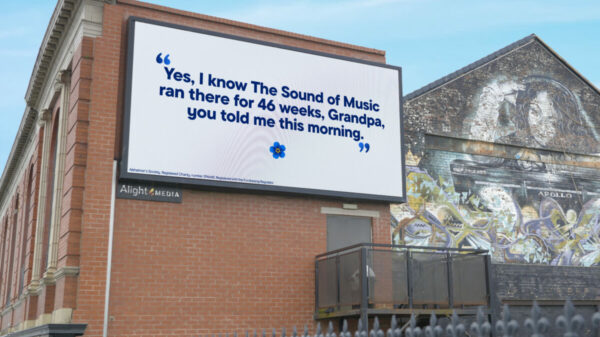I come from a long line of ad critics. My dad chooses to share his opinion by ranting loudly about the same ads cropping up on telly night after night, although his dad prefers the time-honoured technique of channelling his inner zen and muting the TV during ad breaks. I imagine his dad before him just threw the telly out the window, although I can’t be sure.
We all have our little ways of dealing with adverts that annoy us – and yes, that does mean some of us sound like a broken record to the rest of the family who are just trying to scroll through their socials before the ads are over. Me? Well, my release is writing about them.
Yes, I am a journalist for the marketing trade. And yes, there is more than a certain degree of irony in publishing a feature about disliking certain ads. But being a part of this world means that I am a victim of the Baader-Meinhof phenomenon – otherwise known as frequency bias.
You probably are as well. Being part of this industry means we can’t simply ignore the adverts, we can’t switch off or zone out – they are there all the time, beckoning to us, calling to us and – ultimately – annoying the fuck out of us.
Perhaps, then, it’s not so surprising that I feel the need to pick apart the annoying nature of some of those adverts.
Once you’ve found an advert that annoys you, it’s relentless. You might be unwinding on the sofa after a long day, stuck in traffic driving home from work ot listening to the radio in the gym because your headphones are out of charge (just me?). And then – boom. That ad comes on.
While of course the ad itself will end in a matter of seconds, that’s not where the torture ends. You’ll sometimes find yourself humming the tune of the very thing you swore to hate, tapping your pen in time to the beat. The catchy-ness of some of the melodies are enrapturing. Like a mermaid singing to enchant a capsized sailor. You can’t help but keep returning to them. And yes, I know that is the point.
Get out of my head!
The other day, I momentarily stepped outside of my own body to watch myself sing the song from Webuyanycar’s latest ad. The tune is a ‘Just sold my car’ take on a TikTok ‘It’s Friday then’ take on Nightcrawlers’ 1992 hit ‘Push the Feeling On’. It’s all very meta.
It’s a shame really, as what started as an uplifting ad that played upon the vibrancy of TikTok star Mufasa’s original viral video, soon turned into an irritating campaign. Now, when you hear the ad on the radio or see the spot on TV, Mufasa’s excitable chanting and energetic dance moves are replaced by other actors lacking the same physical and singing talent.
Leaving the high levels of irritation to one side, however, the memorability of the ad must be commended. A primary school teacher friend of mine has caught her students singing the song – which, we must remember, is about selling second-hand cars. When an ad is so memorable that it’s even permeating the playground, you know the campaign has been a success.
From pop to opera, the annoying O.G. – GoCompare – and its infamous opera singing ad is the master of forcing you to remember something you don’t want to. And much to the insurance brand’s delight I’m sure.
I’d guarantee that any Brit up and down the country is familiar with Gio Compario and his ear-damaging tune. In 2013, The Guardian reported that the ad had helped drive almost £10 million in royalties for UK songwriters from music used in ads. In 2023, the character is still relevant. He has truly stood the test of time, despite most recently causing controversy for trivialising car crashes.
Like Daryll from Walking Dead being tortured with The Collapsable Hearts Club song ‘Easy Street’, memorability works – even if it does mean pissing someone off.
Taking a slightly more scientific angle on the brain’s ability to recall annoying ads is School of Marketing CEO Ritchie Mehta, who believes that brands that risk audaciousness “often benefit from a significant up-side”.
“The Von Restoff effect shows us that we are programmed to be struck by things that are just different,” Mehta continues.
“Dave Trott, the legendary ad man, explained that our brains work in binary ways, so if ten adverts are similar, we club them together. If we come across an advert that is different, however, it stands out. Our brains give the lion’s share to the advert that is different even if it is jarring. They edge a place in our memory structures.
“When brands add in a catchy jingle, a Tik Tok sensation and dance moves we can all get involved with, they’re really onto a winner.”
What’s annoying for some is a delight for others
It might just be me (although I’m sure it’s not) but I flinch slightly when the meerkat pair come on the screen. Why take these curious and cute looking animals and turn them into an oligarch and a clumsy assistant? Not to mention the repetitiveness, the dull narratives, the terrible accents… and now they’ve chucked a wombat in the mix!
You (or I) would think that absolutely everyone would despise the characters, but apparently not. Their annoying nature seems to have charmed some people. Merchandise for Alexander, Sergei and Oleg has proven to be extremely popular over the years, while the “Simples” catchphrase made it into the public lexicon years ago.
The brand itself has been battling its opera singing counterpart for the title of the most visited price comparison website for years and as a result of some clever (annoying) marketing, whenever your car’s insurance needs renewing you probably think of either GoCompare or Comparethemarket.
Keeping with the idea that ads can be both blood boiling and positively delightful, partner for ad agency BigSmall, Matt Edwards, believes that the Daisy perfume ad from Marc Jacobs is the perfect example of how different people find different campaigns annoying.
“Some of the most annoying commercials can be the most memorable and commercially successful, but it all depends on who they’re annoying and what category the brand is operating in,” he said.
“Type ‘daisy advert’ into Twitter and you’ll see that a lot of people find it excruciating. However, I suspect the young target audience finds the surreal, Midsommar-ish vibes rather attractive, and the fact it annoys the hell out of their parents just adds to the appeal.
“The massive spike in Google search volumes when the campaign runs suggests it’s doing its job rather well.”
Looking to a more recent advert, we have Pringles’ high-pitched-screeching as the perfect example of dividing the nation. The potato snack brand’s ‘Wonderfully Different’ campaign draws parallels between its new ‘different’ flavoured crisps and a uniquely quirky hamster.
The furry rodent suddenly becomes the focus of the ad, rising from the ashes to deliver a ballad for our times. Building intrigue and melancholy with a synth chord, the hamster eventually lets loose a beautiful love cry.
While a commenter on Marketing Beat branded the ad “pants and irritating”, just this once I will hop over the fence into positivity and say: “No anonymous ‘Clare Edwards’. You are wrong. The ad is positively brilliant.”
After all, whether ads are fucking annoying or not is just a matter of opinion.
Subscribe to Marketing Beat for FREE
Sign up here to get the latest marketing news sent straight to your inbox each morning









